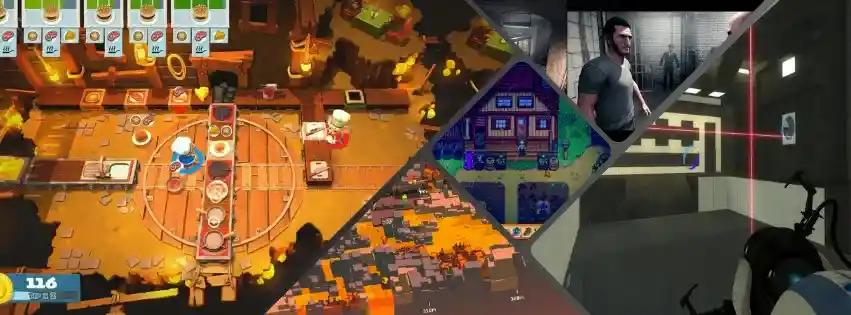Running an RPG on a modest laptop shouldn’t mean compromising on depth. This guide ranks the best role‑playing games that run smoothly on modest PC's and laptops. We scored each title for performance on low-end hardware, strength of RPG systems and choice, replay potential, approachability, and overall enjoyment. The list covers a mix of action RPGs, tactical games, classic CRPGs, and modern indies. You’ll find the top 10 picks in order, plus five honorable mentions worth considering.
This article is part of our guide on the Best Low-End PC Games
How We Ranked These Games
We evaluated each game using a weighted rubric emphasizing reliable performance on integrated GPUs and meaningful role‑playing systems. The table summarizes our criteria and how much each factor influenced the final order.
Criterion | Weight | Why It Matters |
|---|---|---|
Low end compatibility | 40% | Ensures playable performance on integrated GPUs with minimal stutter and fast loads. |
RPG depth and systems | 25% | Rewards builds, stats, dialogue checks, and meaningful player choice. |
Replay value | 15% | Prioritizes multiple builds, routes, and long-term engagement. |
Engagement fun | 10% | Maintains satisfying combat or storytelling even with visuals turned down. |
Accessibility onboarding | 10% | Favors clear tutorials, readable UI, and flexible difficulty for low-tech setups. |
Related reading: Best Open World Games for Low-End PCs
What do we mean with low-end hardware?
So what exactly do we mean when we say low-end hardware? We have to come up with a baseline somehow. To run the games we chose smoothly, make sure your laptop or pc matches at least the minimum specs:
Component | Minimum Requirement | Recommended |
|---|---|---|
CPU | Intel Core i3 / AMD Ryzen 3 (8th gen or newer) | Intel Core i5 / Ryzen 5 |
RAM | 8GB | 16GB |
Storage | 256GB SSD | 512GB SSD |
Graphics | Integrated (Intel UHD / AMD Vega) | Iris Xe or better |
Display | 1080p resolution | 1080p IPS panel |
OS | Windows 10 or 11 | Windows 11 |
Related reading: Best Multiplayer Games for Low-End PCs
The Top 10 Best RPG Games for Low-End PCs
Below are the top 10, ordered by overall score under our low-end policy. Each pick fits modest PCs without sacrificing character builds, choice-driven quests, or long-term play.

Tales of Maj'Eyal
“Deep traditional roguelike with modern UI and hundreds of builds.”
Editors Take
ToME nails the brief: it offers deep character building and modern UX while running on virtually any PC. The tile-based presentation (with an optional lightweight 3D mode) keeps GPU demand negligible, so integrated graphics are no barrier. It excels in long-term play thanks to hundreds of class/race combinations and sprawling skill trees, encouraging experimentation across many runs. The install is tiny, so there’s no storage tax. Onboarding is denser than a casual roguelite, but clear tooltips and adjustable modes soften the learning curve. Free/donationware availability further boosts accessibility without compromising depth.
Full Details
Game Experience

Vampire Survivors
“Addictive bullet-heaven roguelite with zero hardware demands.”
Editors Take
It’s hard to beat this for low-spec performance and pure stickiness. The minimalist 2D presentation runs at 60 FPS on even decade-old integrated GPUs, with community reports confirming smooth play on Intel HD 4000 and newer. While the minute-to-minute inputs are simple, meta-progression, character unlocks, and synergies deliver meaningful build tinkering over dozens of runs. Accessibility is strong—one-handed controls, readable UI, and short sessions make it easy to pick up. It’s lighter in narrative and systems than classic CRPGs, but the replay loop and zero hardware demands justify a top-tier placement.
Full Details
Game Experience

Mount & Blade: Warband
“Medieval sandbox RPG blending first-person combat with army command.”
Editors Take
Warband’s blend of first/third-person melee combat, strategic overworld, and faction politics creates emergent stories that keep replays fresh for years. Technically, it’s a gift to low-end rigs: scalable battle sizes and dated-yet-functional visuals maintain high FPS on integrated GPUs, and the install remains small. Character builds and party composition impact outcomes on and off the battlefield, delivering authentic role-play without heavy CPU or GPU spikes. The learning curve is real, but granular difficulty sliders and a massive mod scene help you tailor the experience. Few RPGs stretch so far while asking so little of your hardware.
Full Details
Game Experience

Disco Elysium: Final Cut
“Philosophical detective RPG with exceptional writing and zero GPU demands.”
Editors Take
Disco Elysium turns low GPU demands into a strength. Its painterly isometric art and Unity foundation run smoothly on Intel UHD/Iris Xe, and full voice acting in the Final Cut elevates immersion without taxing your system. Progression is richly expressed through dialogue checks, thoughts, and internal debates, letting different builds reframe scenes rather than just buff stats. It’s lighter on replay than sandbox RPGs, but the density of choice and consequences per hour is exceptional. For players prioritizing story depth and role-play over combat—and using modest hardware—this is an easy recommendation.
Full Details
Game Experience

Dragon Age: Origins
“BioWare's tactical fantasy RPG with branching origins and party-based combat.”
Editors Take
Origins remains a benchmark for party-based tactics and branching story on lightweight hardware. Its 2009 tech rarely stresses a modern iGPU, delivering high frame rates at 1080p low settings. Origin stories, class specializations, and party tactics support varied builds across replays, while the tactical pause keeps combat readable for low-spec users running reduced effects. The install is moderate, not bloated, and stability is strong. It lacks some of the systemic sprawl of newer CRPGs, but the mix of narrative agency and approachable performance makes it a reliable pick for budget laptops.
Full Details
Game Experience

SKALD: Against the Black Priory
“Retro-styled cosmic horror CRPG with modern quality-of-life features.”
Editors Take
SKALD shows that a 2024 release can be both atmospheric and low-impact on hardware. Its crisp pixel art and modern engine load instantly on SSDs and run flawlessly on integrated GPUs, while the ruleset blends classic dungeon-crawling with contemporary quality-of-life. Choice-driven quests and class customization add real role-play without burying newcomers in cruft. The footprint is tiny, and Steam reviews cite smooth performance even on older laptops. It’s tighter in scope than sprawling sandbox RPGs, but the combination of fresh design, strong optimization, and build flexibility earns this high placement.
Full Details
Game Experience

Shadowrun: Dragonfall - Director's Cut
“Cyberpunk tactical RPG blending magic and tech in dystopian Berlin.”
Editors Take
Dragonfall’s tight tactical encounters and reactive checks deliver satisfying role-play without punishing your hardware. The isometric 2D presentation and lightweight engine run smoothly on UHD/Vega iGPUs at 1080p, and load times are minimal. Its cyberpunk setting, dialogue checks, and team builds offer legitimate character expression, while the Director’s Cut streamlines systems and adds content. Although its campaign is shorter than enormous CRPGs, the focus and polish make every mission count. The small install and reliable stability align perfectly with low-end constraints, justifying its strong ranking in a stacked field.
Full Details
Game Experience

Cassette Beasts
“Monster-collecting RPG with fusion mechanics and open-world exploration.”
Editors Take
A modern indie that respects weak GPUs, Cassette Beasts runs at 60 FPS on Iris Xe/UHD with low-to-medium settings thanks to the Godot engine’s efficiency. Its monster fusion system enables creative team-building far beyond typical collectors, while an open world and flexible party tools keep experimentation rewarding. The install is small, shader stutter is rare, and onboarding is friendly without dumbing down systems. It’s not as sprawling as classic CRPGs, but it brings timely polish and strong optimization—exactly the kind of 2023 release low-end players should seek out.
Full Details
Game Experience

Fallout: New Vegas
“Post-apocalyptic RPG masterpiece with unmatched faction depth and build freedom.”
Editors Take
Few RPGs deliver as much choice and build freedom while staying friendly to older hardware. New Vegas typically runs 30–60 FPS at 720p–1080p low on integrated GPUs, with a compact install. Factions, skill checks, and perks enable radically different playthroughs. Engine quirks remain, so optional community patches like NVAC/NVSE are recommended to smooth crashes and scripting hitches—useful on low-end CPUs—but they aren’t required to enjoy the game. That slight stability caveat drops it a notch, yet its depth, replay value, and lean footprint make it a cornerstone of this list.
Full Details
Game Experience

Vampire: The Masquerade - Bloodlines
“Cult classic vampire RPG with clan-based builds and dark storytelling.”
Editors Take
Bloodlines is a seminal choice-driven RPG that runs beautifully on today’s iGPUs thanks to its early Source engine. Clan selection meaningfully alters dialogue, quests, and playstyles, delivering strong replay value without heavy system strain. The catch: stability on modern Windows effectively requires the Unofficial Patch—hence a small ranking penalty for that dependency. Once patched, performance is excellent and the install is tiny, avoiding storage bloat. For players comfortable with a quick community fix, it remains one of the most atmospheric and flexible urban fantasy RPGs available on low-end hardware.
Full Details
Game Experience
Related reading: Top 10 Co-Op Games for Low-End Laptops
Honorable Mentions
These five games perform well on modest hardware and add genre variety, but small drawbacks in replay hooks, onboarding, or stability kept them outside the top 10.
Sea Of Stars (itch)
Sea of Stars pairs beautiful 2D/3D hybrid art with timing-based combat that stays smooth on integrated GPUs, making it a safe modern pick for modest machines. The presentation is polished, the soundtrack shines, and the install is lean. Its progress systems are intentionally streamlined, and the campaign is largely a one-and-done journey with limited build variance, so it trails titles that support wildly different second and third runs. If you want a contemporary JRPG that feels great at 1080p on low-end hardware, this is a strong choice—just lighter on long-term replay.
Battle Brothers
This brutal tactical RPG thrives on integrated GPUs thanks to simple 2D visuals and modest CPU load. Procedural campaigns, mercenary roster building, and permadeath create gripping emergent stories that can last hundreds of hours. However, the onboarding is unforgiving—loss spirals and opaque early decisions can punish new players, reflecting a steeper learning curve than our top 10. If you relish high-stakes tactics and don’t mind a rough start, Battle Brothers is outstanding. Its difficulty wall and sparse tutorialization are the main reasons it lands just outside the primary ranking.
Etrian Odyssey Origins Collection
These remasters run cleanly at 1080p on iGPUs and deliver deep party customization with satisfying map-drawing. The trilogy’s focused dungeon design and low overhead make it an excellent fit for laptops. It narrowly misses the top 10 because the experience is intentionally methodical and grind-prone, with limited narrative reactivity and less build expression across replays compared with sprawling CRPGs. If you enjoy optimizing party roles and slowly conquering labyrinths, it’s highly rewarding; we simply prioritized entries with broader player agency and more varied second-run outcomes.
CrossCode
CrossCode’s efficient 2D engine, small install, and crisp sprite work make it friendly to integrated graphics. It’s an action RPG with satisfying combat, clever puzzles, and MMO-flavored quests that add meaningful stat and gear progression. The reason it falls short of the top 10: difficulty spikes and puzzle density can be taxing for players seeking quick, low-friction sessions on modest rigs, and its replay hooks are lighter than the roguelikes and sandboxes above. Still, for action-forward fans on low-end hardware, it’s a smart, polished choice.
Pillars of Eternity
Pillars delivers classic isometric party combat, rich lore, and reactive quests, all running reliably on UHD/Vega at 900p–1080p with sensible settings. It’s a great fit for low-end systems compared to many modern CRPGs, though long loads and heavier zones can cause occasional hitches on older CPUs. The install is larger than some peers, and replay incentives are modest next to New Vegas or ToME. It’s still a strong recommendation for anyone craving Infinity Engine DNA on a budget laptop—just edged out by entries with leaner performance profiles and higher replay pull.
Related reading: Best Offline Games for Low-End PCs
Frequently Asked Questions
Here are quick answers to common questions about running RPGs on low-end PCs, covering hardware baselines, tweaks, and what to expect from performance and features.
What specs count as a “low-end PC” for this list?
We target systems around an Intel Core i3 or Ryzen 3 CPU, 8GB RAM, integrated graphics (Intel UHD, AMD Vega, or Iris Xe), and a SATA/NVMe SSD on Windows 10/11. Our picks aim for 720p–1080p at low settings and a consistent 30 FPS or better, with minimal shader stutter and reasonable load times.
Will these games run on very old iGPUs like Intel HD 4000?
Many will, especially 2D and isometric titles. Expect to drop resolution to 720p and disable heavy effects. Community reports and PCGamingWiki entries indicated smooth results for several picks on HD 4000, but performance varies per game. Start with low presets, cap FPS, and use borderless windowed mode if needed.
Do I need mods to play smoothly?
No. All top picks are playable without mandatory tweaks. We only note optional community fixes that improve stability or quality of life. One exception is Vampire: The Masquerade – Bloodlines, which effectively requires the Unofficial Patch for stable play on modern Windows; we applied a small penalty for that dependency.
How did you verify low-end performance?
We combine hands-on experience with evidence from PCGamingWiki, developer notes, Steam user reports (including Deck Verified status when relevant), and community benchmarks for Intel UHD/Vega/Iris Xe. We penalize games with heavy shader-compilation stutter, bloated installs, or CPU spikes that routinely drop below 30 FPS on target hardware.
Are there recent (2023–2025) games in the list?
Yes. SKALD: Against the Black Priory (2024) and Cassette Beasts (2023) make the top 10 thanks to excellent optimization and strong RPG systems. Sea of Stars (2023) appears as an honorable mention for its great performance and accessibility despite lighter build depth.
Why did a classic like Skyrim not make the list?
We did definitely consider and score it for this review, however we found that it's performance on really low-end hardware was too borderline for it to make the final list. With so many great alternatives, Skyrim did not make the final cut.
Related reading: Best Shooting Games for Low-End PCs
Conclusion
These recommendations prioritize smooth play on integrated graphics without sidelining character builds, meaningful choices, or replay value. From classic CRPGs to modern indies, each pick was scored for performance, system depth, longevity, and approachability, with optional tweaks noted but not required. Whether you’re theory‑crafting in a roguelike or navigating a dialogue-heavy narrative, the top 10 and honorable mentions give you stable options that respect limited hardware and storage. Ready for more tailored picks? Try our Recommendations Engine for suggestions that match your play style.









